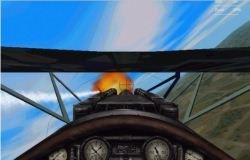| The Art of Guns Combat
by Dennis Greene |
||||
|
AERODYNAMICS This is the boring physics lecture, don't nod off just yet, though. You really need to know this stuff. Literally hundreds of green pilots have lost their lives (and thousands of sim lives) because they thought they knew how their plane would react. The only way (let me stress that - the ONLY way) to really be in control of your plane is to understand the forces acting on it and the way the control surfaces manipulate those forces. You don't have to memorize Bernoulli's equation, but you'd better understand what it means for your wings. The pilot who has the aerodynamics ingrained in his head can overcome virtually any enemy, including the "ace-killer", an uncontrolled spin. Five vs. Four Forces Many texts will tell you there are four primary forces acting on your plane. They are wrong. There are five forces you need to contend with. With propeller-driven planes torque is the fifth force you need to be aware of. Here are the five forces broken down for you: Gravity - This one is easy. You deal with it every day. Your plane and everything in it are attracted to the surface of planet earth. The more weight (Mass) in your plane, the greater the attraction. If there were no other forces acting on your plane, gravity would pull your plane to the ground and keep it there. Drag - If gravity was pulling you down, drag would limit how fast you would fall. In simple terms, drag is the resistance the air offers on anything trying to move through it. A moving plane with no force propelling it would quickly slow down and stop because of the force of drag acting on it. Thrust - This is what keeps your plane moving through all that resistance. The spinning propeller pushes the air backwards, which brings us to Newton's equal and opposite reaction - a forward motion of the plane. Of course thrust combines with gravity to increase the speed of your dives. Lift - Is what keeps you in the air. The plane's wings are designed to take advantage of a side effect of the law of conservation of energy. The curvature of the wing means that air must move faster going over the top of the wing then it does passing below it. This produces a side effect where a lower pressure exists above than below (the pressure determined in Bernoulli's equation), and the difference in pressure between bottom and top creates lift. When the lift on both wings is great enough to overcome gravity, the plane is held aloft. With lift and thrust both working to counteract the laws of nature, your plane flies. |

iMagic's Dawn of Aces. Torque - This is the last and often forgotten force for a propeller driven plane and is the twisting effect caused by the engine and propeller. In the WWI aeroplanes the torque you need to worry about is caused primarily by radial engines. These engines rotate in one direction, and that direction coincides with the roll axis of the plane. Some of the torque generated by the engine's rotation is transferred to the body of the plane, which makes the plane try to rotate in the opposite direction as the engine. If the pilot does not compensate for this (using rudder), the torque will cause the plane to roll. This is especially dangerous at low airspeeds and when landing. I've mentioned Bernoulli's equation several times, in case you were wondering what that equation is, I'll give it to you: P+1/2pu2+pgy=K This means that for any particular volume of air, the sum of its pressure (P), kinetic energy (1/2pu2), and potential energy (pgy) stays constant (=K). Meaning, roughly, that the faster a volume of air moves, the lower its pressure. THE THREE AXES A plane can move in any number of directions. To simplify this concept we will discuss a reference based on three axes of motion. By design, these axes relate to the three main types of motion you can control in your plane. Pitch - is the up and down movement of the plane's nose around an axis line drawn from wingtip to wingtip. You apply pitch by pulling back on the stick which angles the plane's elevators up, causing the nose to rise. When you push the stick forward, you angle the elevators down, causing the nose to drop. Roll - is the tipping of the wings up or down causing a roll. The plane continues to fly in its current direction, but the wings spin around an imaginary line drawn from the nose to the tail. Roll occurs when you push the stick left or right, causing one aileron to angle down and the other to angle up. This is not merely air deflection but actually modifies the characteristics of the wing, increasing lift under one wingtip, while decreasing lift under the other. This differential in lift causes the plane to roll. Yaw - is the side-to-side motion of the plane's nose around a vertical axis through the center of the plane. It changes the direction of horizontal flight, but does not affect altitude. You use the pedals to angle the plane's rudder left or right, which creates yaw. Go to Page Three
|
|||
|
Copyright © 1997 - 2000 COMBATSIM.COM, INC. All Rights Reserved. Last Updated April 19th, 1999 |
||||
